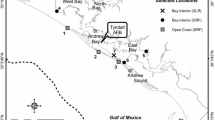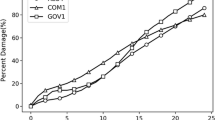Abstract
In response to the 2004 and 2005 hurricane seasons, surge risk assessment approaches have been re-evaluated to develop more rapid, reliable methods for predicting the risk associated with extreme hurricanes. Here, the development of dimensionless surge response functions relating surge to hurricane meteorological parameters is presented. Such response functions present an opportunity to maximize surge data usage and to improve statistical estimates of surge probability by providing a means for defining continuous probability density functions. A numerical modeling investigation was carried out for the Texas, USA coastline to develop physical scaling laws relating storm surge response with hurricane parameters including storm size, intensity, and track. It will be shown that these scaling laws successfully estimate the surge response at any arbitrary location for any arbitrary storm track within the study region. Such a prediction methodology has the potential to decrease numerical computation requirements by 75% for hurricane risk assessment studies.


















Similar content being viewed by others
Abbreviations
- ADCIRC:
-
ADvanced CIRCulation model, a finite-element long-wave numerical model
- B :
-
Hurricane pressure profile peakedness parameter (Holland 1980)
- c p :
-
Hurricane central barometric pressure, a measure of hurricane intensity
- JPM:
-
Joint probability method
- JPM-OS:
-
Joint probability method with optimal sampling
- m x :
-
Location-dependent constant relating hurricane surge to intensity
- R p :
-
Hurricane pressure radius, a measure of hurricane size
- R thresh :
-
Threshold hurricane pressure radius for small storms
- R′:
-
Dimensionless hurricane pressure radius
- X :
-
Distance alongshore
- x′:
-
Preliminary dimensionless alongshore distance
- x 2′:
-
Dimensionless alongshore distance
- x o :
-
Distance alongshore, x, at the eye location at landfall
- \( x_{{\zeta_{\text{peak}} }} \) :
-
Distance alongshore, x, at the location of peak alongshore surge
- (x, y):
-
Geographic position
- (x o, y o):
-
Geographic position of storm eye at landfall
- Δp :
-
Central pressure deficit
- γ:
-
Specific weight of water
- λ:
-
Constant relating location of peak alongshore surge to storm size
- Φ:
-
Dimensionless surge response surface
- \( \phi_{\text{km}} \) :
-
Dimensional surge response function
- ζ :
-
Maximum hurricane surge at a given location (x, y)
- ζ ′ :
-
Dimensionless surge
- \( \zeta_{\text{peak}} \) :
-
Peak alongshore surge
- ζ sim :
-
Numerically simulated maximum hurricane surge at a given location (x, y)
- ζ Φ :
-
Predicted maximum hurricanes surge at a given location (x, y) using surge response function
References
Dorst N (2007) What is the average forward speed of a hurricane? In Hurricane Research Division Frequently Asked Questions. National Oceanic and Atmospheric Administration. http://www.aoml.noaa.gov/hrd/tcfaq/G16.html
Holland GJ (1980) An analytic model of the wind and pressure profiles in hurricanes. Mon Weather Rev 108:1212–1218. doi:10.1175/1520-0493(1980)108<1212:AAMOTW>2.0.CO;2
Irish JL, Resio DT, Ratcliff JJ (2008) The influence of storm size on hurricane surge. J Phys Oceanogr (online) doi:10.1175/2008JPO3727.1
Niedoroda AW, Resio DT, Toro G, Divoky D, Reed C (in review) Emerging methods for evaluation of the coastal hurricane storm surge hazard. Ocean Engineering
Resio DT, Irish JL, Cialone MA (2009) A surge response function approach to coastal hazard assessment – part 1: basic concepts. Nat Hazards. doi:10.1007/s11069-009-9379-y
Thompson EF, Cardone VJ (1996) Practical modeling of hurricane surface wind fields. J Waterw Port C ASCE 122(4):195–205
U.S. Army Corps of Engineers (2006a) Performance evaluation of the New Orleans and southeast Louisiana hurricane protection system draft final report of the Interagency Performance Evaluation Task Force. U.S. Army Corps of Engineers Report, 259 pp
U.S. Army Corps of Engineers (2006b) Louisiana Coastal Protection and Restoration (LACPR) preliminary technical report—appendix B—history of hurricane occurrences. U.S. Army Corps of Engineers New Orleans District Report
Westerink JJ, Luettich RA, Baptista AM, Scheffner NW, Farrar P (1992) Tide and storm surge predictions using finite element model. J Hydr Eng 118(10):1373–1390. doi:10.1061/(ASCE)0733-9429(1992)118:10(1373)
Westerink JJ, Luettich RA, Feyen JC, Atkinson C, Dawson MD, Powell JP, Roberts HJ, Kubatko EJ, Pourtaheri H (2007) A basin to channel scale unstructured grid hurricane storm surge model as implemented for southern Louisiana. Mon Weather Rev 136:833–864
Acknowledgments
The research presented herein was funded by the U.S. Army Engineer Research and Development Center and in part by a Grant/Cooperative Agreement from the National Oceanic and Atmospheric Administration. The views expressed herein are those of the authors and do not necessarily reflect views of NOAA or any of its subagencies. The use of trade names does not constitute an endorsement in the use of these products by the U.S. Government.
Author information
Authors and Affiliations
Corresponding author
Rights and permissions
About this article
Cite this article
Irish, J.L., Resio, D.T. & Cialone, M.A. A surge response function approach to coastal hazard assessment. Part 2: Quantification of spatial attributes of response functions. Nat Hazards 51, 183–205 (2009). https://doi.org/10.1007/s11069-009-9381-4
Received:
Accepted:
Published:
Issue Date:
DOI: https://doi.org/10.1007/s11069-009-9381-4




